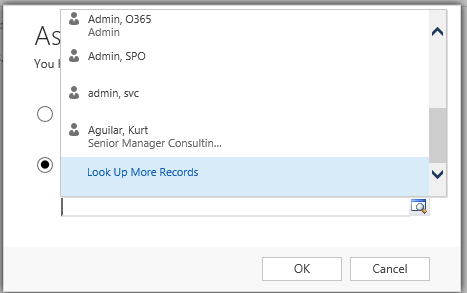When you click the “assign” button to assign a record to a user, you can only choose an active/enabled user, right?
Wrong.
When you click the assign button and select “Assign to another user or team,” you only see enabled users listed. This is because the lookup field is set to use the “Enabled Users” list.
But if you click the lookup button, scroll down to select “lookup more records,” the lookup dialog will appear. From there, you can select any view, including the disabled user view.
From the disabled user view, you can select a disabled user and assign the record to that user.
Why would you want to do this?
Typically you want active records to be owned by enabled users; however, there are several scenarios where you would want to assign records to users who are no longer with your company. For example, say you are creating or importing some legacy opportunity records. in this case, you might want to have the opportunity owned by the original owner, as it will be valuable to know who the sales representative was at the time of the sale.
 of the
of the
#247
Would this inherently convert all open activities to the new team (or user) assigned? Or would we still have to run a workflow on the back end to fully clean this up?
The assignment (or reassignment) of a record depends on your cascading relationship settings. If you have the default setting in the relationship between accounts and phone calls and you reassign the record, the phone calls will be reassigned. We have multiple tips regarding cascading relationship management. I recommend you check them out.
I think this has changed very recently in D365 online so that you can no longer assign records to disabled users.
( It’s just cropped up in a long running migration project 🙁 )
(In case you can see my earlier comment about this no longer working, you might need to scratch that!
It’s definitely not worked for a few days – it gave a “your user is disabled”-ish message in several orgs.
(These orgs were in the same tenancy – we checked another tenancy and it worked there but thought it was to do with a difference in versions, the problem tenancy being on 9.2.23031 and the one that worked being on 024.)
However, having retried again this morning, we find it’s working working again in all of the 031 orgs – still on the same version!
(Solution history says 5 MicrosoftCorporation / microsoftdynamics solutions have been installed overnight, but they’re all MicrosoftFlowExtentions* so don’t really look related.)
I think it depends on D365 release wave if it works or not.
I tested on 2023 release wave 2 enabled and it worked, but didn’t work on 2022 release wave 1 enabled.